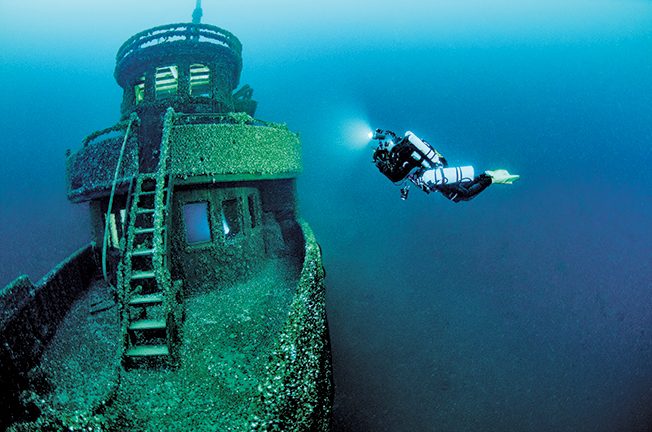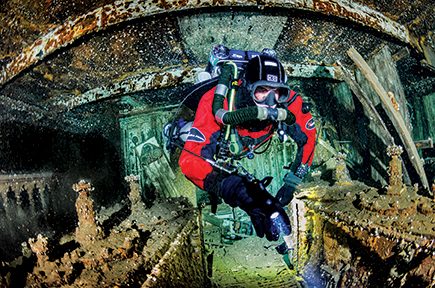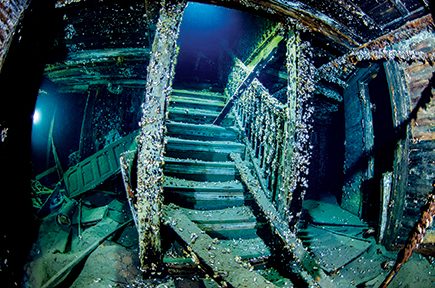Georgian Bay Gem
NORTH AMERICA’S GREAT LAKES have long provided a natural transportation corridor to the continent’s interior. The Anishinaabe people — the region’s original inhabitants — utilized the Great Lakes for trade, passage, and nourishment and developed a rich culture centered around them.
Many Indigenous peoples believed in the malevolent lake creature called Mishipeshu in Ojibwe, which was said to be capable of creating violent storms, waves, and whirlpools and even causing ice to break in midwinter. Paying respect and caution to Mishipeshu would ideally provide safety and protection for those who traveled on the lakes.
The first explorations into the continent by European pioneers and settlers used the Indigenous peoples’ routes. At first they built small sailing ships to reach remote wilderness outposts. By the mid-1800s, a growing fleet of large steamers and sailing vessels facilitated commercial transportation and trade as they accessed ports throughout the entire Great Lakes region.
This necessity for moving goods and people led to the design and construction of the humble coastal steamer typical of the second half of the 19th century. These ships were the multipurpose transports of the era, able to carry finished goods, raw materials, livestock, and paying customers to their destination of choice. They were narrow and tall, often with staterooms on the upper deck, so they could dock at any remote port but still hold enough cargo to make the trip financially practical.


Le SS Manasoo was such a ship. William Hamilton and Co. built it in Scotland in 1888 for the Hamilton Steamboat Co. in Ontario. Originally named the Macassa, the ship’s first career primarily was ferrying people between Toronto and Hamilton, Ontario.
In 1905 the Collingwood Shipbuilding Co. lengthened the ship by 23 feet to 178 feet (54 meters), and the aging Macassa had another rebuild in late 1927 before reentering service as the Manasoo the following year. The ship then operated on Georgian Bay and the North Channel in Lake Huron, making stops at ports between Owen Sound, Ontario, and Sault Ste. Marie, Ontario.

In September 1928, ranch owner Don Wallace hired the Manasoo and brought aboard his newly purchased Chevrolet coupe for his journey north. He planned to buy cattle from farms near Manitoulin Island, Ontario, and ship them back to port at Owen Sound. After a successful business trip to acquire 116 cattle, the crew of 19, along with Wallace and his friend George Maurice Lambert, steamed south into the open waters of Georgian Bay as an approaching storm closed in.
By 2 a.m. on Sept. 15, the situation aboard the Manasoo was dire. The ship had developed a severe list off Griffith Island as the large waves relentlessly battered it. Capt. John McKay ordered the Manasoo to turn toward the imposing lighthouse with hopes of beaching the vessel, but not even five minutes later the ship vanished beneath the waves.
One raft broke free from the Manasoo as it plunged to the bottom, and six people managed to climb aboard the lifeboat in the dark, howling night. They were at the mercy of the elements for 60 hours while adrift in the open water, sun-scorched during the day and freezing at night. When the passing steamship SS Manitoba finally rescued them, only five survivors remained: McKay, Wallace, Oswald Long, Arthur Middleboro, and Roy Fox.
Le Manasoo was lost and forgotten beneath the cobalt-blue waters of Georgian Bay for 90 years. Shipwreck hunters Ken Merryman, Jerry Eliason, and Cris Kohl located the upright and intactwreck in June 2018 in 205 feet (62 meters) of water.
A dive to the Manasoo’s deck is always an incredible experience. Seeing an undisturbed shipwreck with artifacts scattered about is a haunting privilege. We have long known that the Great Lakes’ cold, fresh waters can result in extraordinary preservation of shipwrecks, but seeing them in person never gets old.

Reminders of the ship’s crew are everywhere — plaques and signs in the engine room, the chief engineer’s bicycle he used while in port, dishes and cutlery tossed about. The defining line between past and present seems very thin here, with history just out of reach. The pilot house, where McKay gave the last desperate orders, remains intact. The massive wooden wheel looms in eternal twilight at this depth, appearing ready for service. A clock still hangs on the wall. The ship’s compass is perfectly preserved and looks functional after all this time.
Wallace’s 1927 Chevrolet AA Capitol coupe remains parked by the loading door on the lower deck with the Ontario license plate still on the rear bumper. The passenger door is ajar, and windshield glass rests on the hood, where the Chevrolet logo cast in aluminum is clearly visible. Cattle remains are everywhere, making the sight even more tragic. It must have been a truly terrifying experience in the middle of the stormy night with water pouring in and only minutes to find your way to a lifeboat.

The midship staircase leading from the main cargo deck up to the stateroom passageway is one of the highlights of the dive, and you can view it from the ship’s exterior. The passenger staterooms still contain bunk beds, overhead lights with intact bulbs, and personal items strewn about. The interior is both delicate and dangerous; hazards are everywhere. Collapsed walls, fallen timbers, and fine silt demand the total concentration of the diver willing to venture inside. This is not a dive for training your skills; this is the dive you train for.
Le Manasoo’s aft third shows signs of impact with the lake bottom and confirms the reports that the ship sank stern first. The bottom has wreckage and artifacts scattered about, with a bench from the upper deck lying in the debris field. Nearby, one of several lifeboats rests on the lake bottom, oars still tied in place.
Visiting the Manasoo requires some planning and effort. This site is in a relatively remote part of southern Ontario with no dive shops or fill stations nearby, so being self-sufficient is necessary. Water temperatures are typical for this part of the Great Lakes. Georgian Bay is never really warm, but thermoclines in late summer can result in temperatures of 50°F (10°C) above 30 feet (9 meters). Below this depth, the temperature is typically 39°F (4°C) or colder.
Visibility often exceeds 100 feet (30 meters) and gives the appearance of warm Caribbean water — a notion quickly dismissed after dropping through the thermocline. Drysuits make for a more enjoyable dive, and given the depth, expect a decompression schedule. Trimix and rebreathers have greatly enabled self-sufficiency in remote areas and are of benefit here too.
There are several theories about the cause of sinking: The additional length added during the refit made the ship inherently unstable, cattle shifting to one side of the vessel caused it to list dangerously, or it was simply an old, poorly maintained steamer past its prime and in the wrong place at the wrong time.
Or perhaps old Mishipeshu felt proper respect had not been paid and wished to remind those traveling the Great Lakes to proceed cautiously. The challenges of diving the Manasoo are not insignificant, but neither are the rewards. AD
© Alert Diver - Q3 2023